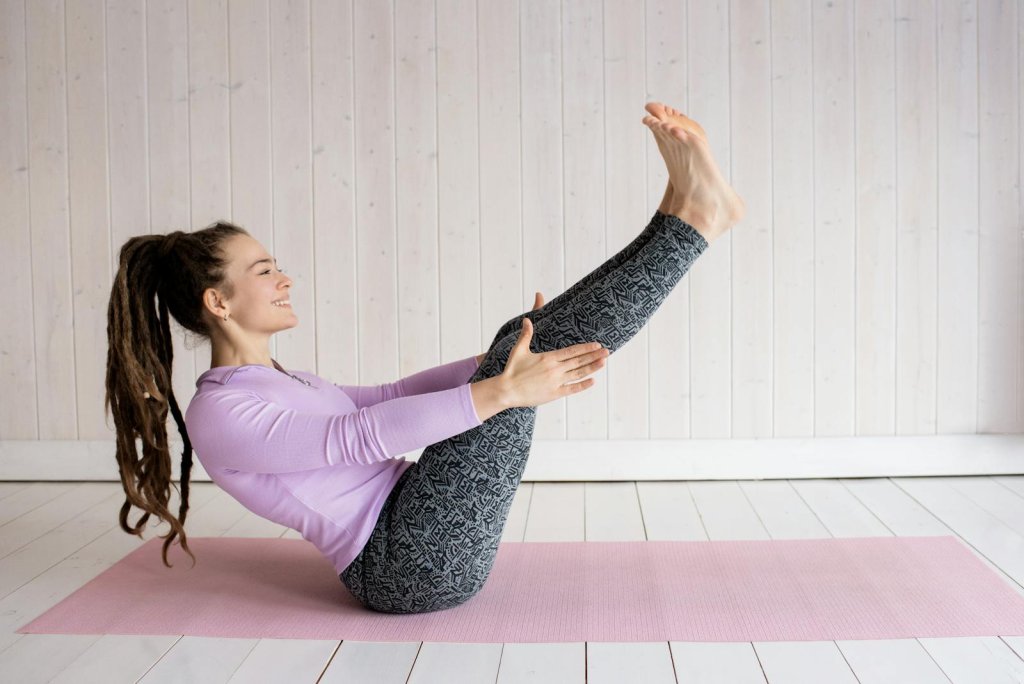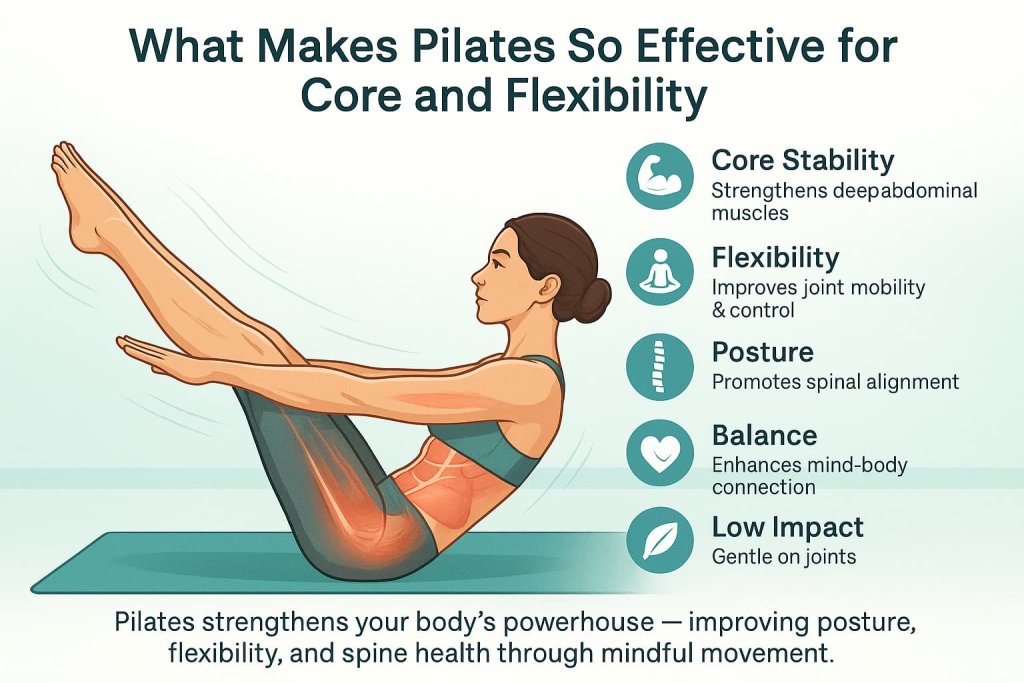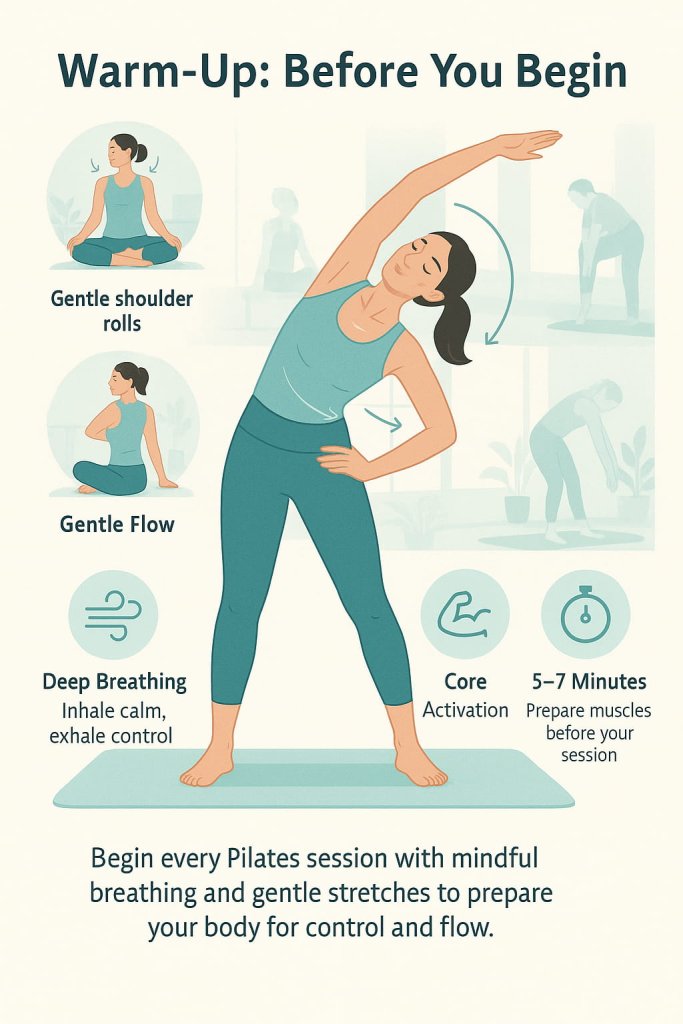Pilates is one of the most effective ways to strengthen your core and improve flexibility fast.
It combines controlled movement, mindful breathing, and deep muscle activation to build stability, balance, and mobility — all without heavy equipment.

Whether you’re a beginner or experienced, Pilates helps sculpt lean muscles, enhance posture, and reduce tension. In this guide, you’ll discover 20 of the best Pilates exercises that target your abs, hips, glutes, and back while improving full-body control and flexibility.
Let’s explore the most effective mat-based moves that can transform your strength and mobility safely at home or in the studio.
What Makes Pilates So Effective for Core and Flexibility
Pilates focuses on the body’s “powerhouse” — the deep abdominal and spinal muscles that support every movement.

Pilates focuses on the body’s “powerhouse” — the deep abdominal and spinal muscles that support every movement. It improves posture, balance, and joint-friendly strength, and systematic reviews show it can reduce chronic low-back pain. (BMC Musculoskeletal Disorders 2024)
Key benefits include:
- Builds a stronger, more stable core
- Increases flexibility and mobility
- Improves posture and alignment
- Reduces stress and muscle tension
- Supports healthy spine and joint function
Warm-Up: Before You Begin

Before performing Pilates exercises:
- Spend 5–7 minutes warming up with gentle stretches and deep breathing.
- Focus on core engagement (“navel to spine”) and controlled movements.
- Avoid jerky motions — precision and flow are key.
20 Best Pilates Exercises for Core Strength and Flexibility
Each move below includes its purpose, key muscles worked, and step-by-step technique.
1. The Hundred
Why it works:
This classic warm-up move increases circulation, fires up your core, and preps your body for deeper Pilates exercises.
Muscles worked:
Abdominals, hip flexors, diaphragm.
How to do it:
- Lie on your back with legs lifted at a 45° angle.
- Lift your head, neck, and shoulders while extending your arms alongside your body.
- Pump your arms up and down 100 times while breathing in for 5 counts and out for 5 counts.
Trainer Tip:
Keep your lower back pressed firmly into the mat to protect your spine.
2. Roll-Up
Why it works:
Improves spinal flexibility and strengthens abdominal muscles through controlled articulation.
Muscles worked:
Rectus abdominis, hip flexors.
How to do it:
- Lie flat with arms extended overhead.
- Inhale to prepare, then exhale to roll up slowly and reach toward your toes.
- Roll back down one vertebra at a time with full control.
Trainer Tip:
Move with precision and avoid using momentum for a smoother flow.
3. Single Leg Circles
Why it works:
Strengthens your core and enhances hip mobility, helping balance and coordination.
Muscles worked:
Core, hip flexors, thighs.
How to do it:
- Lie on your back with one leg extended upward and the other flat on the mat.
- Circle your raised leg across the body, down, and around for 5 reps each direction.
Trainer Tip:
Keep hips stable — imagine they’re glued to the mat.
4. Rolling Like a Ball
Why it works:
Massages the spine, improves balance, and strengthens the core.
Muscles worked:
Core, spine stabilizers.
How to do it:
- Sit with knees pulled to your chest and hold your shins.
- Balance on your tailbone, roll backward to your shoulders, then return to the start.
Trainer Tip:
Keep your chin tucked and spine rounded for safety.
5. Single Leg Stretch
Why it works:
Builds lower ab endurance and promotes coordination.
Muscles worked:
Rectus abdominis, hip flexors.
How to do it:
- Lie on your back, knees bent.
- Pull one knee to your chest while extending the other leg at a 45° angle.
- Switch legs smoothly in a scissor motion.
Trainer Tip:
Lift your shoulders and maintain steady breathing.
6. Double Leg Stretch
Why it works:
Engages the deep core and challenges coordination between arms and legs.
Muscles worked:
Transverse abdominis, rectus abdominis.
How to do it:
- Lie on your back, hug both knees to your chest.
- Inhale, extend arms and legs outward.
- Exhale, circle arms around and pull knees back in.
Trainer Tip:
Move slowly — feel the stretch, not the strain.
7. Spine Stretch Forward
Why it works:
Improves posture, spinal articulation, and hamstring flexibility.
Muscles worked:
Core, lower back, hamstrings.
How to do it:
- Sit tall with legs extended and slightly apart.
- Inhale to lengthen, exhale to reach forward, rounding the spine.
Trainer Tip:
Keep shoulders relaxed — movement starts from your core.
8. Open Leg Rocker
Why it works:
Enhances balance, control, and spinal mobility.
Muscles worked:
Core, hip flexors, lower back.
How to do it:
- Sit holding your ankles, legs extended in a V shape.
- Rock back to shoulders, then return to balance upright.
Trainer Tip:
Engage your abs to stay centered throughout the motion.
9. Corkscrew
Why it works:
Strengthens obliques and teaches rotational control.
Muscles worked:
Abs, obliques, hip flexors.
How to do it:
- Lie flat, legs together, lifted at 90°.
- Circle both legs together clockwise, then counterclockwise.
Trainer Tip:
Keep shoulders and upper back anchored to the mat.
10. Saw
Why it works:
Enhances spinal rotation and stretches the hamstrings.
Muscles worked:
Core, obliques, hamstrings.
How to do it:
- Sit tall with legs wide.
- Twist and reach your pinky finger toward the opposite foot.
Trainer Tip:
Anchor your hips evenly to avoid leaning.
11. Swan Dive
Why it works:
Strengthens spinal extensors and opens the chest for better posture.
Muscles worked:
Back extensors, glutes, shoulders.
How to do it:
- Lie on your stomach with palms under shoulders.
- Inhale and lift your chest and legs off the floor, balancing on your abdomen.
Trainer Tip:
Engage glutes to protect the lower back.
12. Single Leg Kick
Why it works:
Improves flexibility in the hamstrings and strengthens glutes.
Muscles worked:
Glutes, hamstrings, lower back.
How to do it:
- Lie on your stomach, propped on forearms.
- Alternate kicking each heel toward your glutes.
Trainer Tip:
Keep abs pulled in and hips pressed to the mat.
13. Double Leg Kick
Why it works:
Strengthens the upper back and glutes while improving posture.
Muscles worked:
Glutes, spinal erectors, hamstrings.
How to do it:
- Lie face down, hands clasped behind your back.
- Kick both legs toward glutes, then extend arms and lift your chest.
Trainer Tip:
Lift smoothly — don’t jerk your neck or shoulders.
14. Teaser
Why it works:
Develops total core strength and coordination between upper and lower body.
Muscles worked:
Abs, hip flexors, spinal stabilizers.
How to do it:
- Lie on your back, extend legs at 45°.
- Inhale to lift arms, head, and chest into a V-sit position.
- Exhale and roll back down.
Trainer Tip:
Keep movements slow and controlled to maintain balance.
15. Leg Pull Front
Why it works:
Strengthens the entire core while engaging the glutes and upper body.
Muscles worked:
Core, triceps, glutes.
How to do it:
- Start in plank position.
- Lift one leg a few inches, hold briefly, and switch sides.
Trainer Tip:
Avoid sagging hips — maintain a straight body line.
16. Side Kick Series
Why it works:
Tones hips, thighs, and improves pelvic stability.
Muscles worked:
Glutes, obliques, hip abductors.
How to do it:
- Lie on one side, top leg straight and lifted.
- Swing the top leg forward and back with control.
Trainer Tip:
Engage abs to keep your torso from rocking.
17. Criss-Cross
Why it works:
Targets the obliques and improves rotational strength.
Muscles worked:
Obliques, abdominals, hip flexors.
How to do it:
- Lie on your back with hands behind your head.
- Bring one elbow toward the opposite knee, switching sides rhythmically.
Trainer Tip:
Exhale deeply during each twist to engage your core fully.
18. Swimming
Why it works:
Improves spinal stability, coordination, and back endurance.
Muscles worked:
Back, glutes, shoulders.
How to do it:
- Lie face down, arms extended overhead.
- Lift opposite arm and leg, alternating in a fluttering motion.
Trainer Tip:
Keep your neck neutral — look slightly forward, not up.
19. Seal
Why it works:
Boosts coordination, spinal flexibility, and strengthens stabilizers.
Muscles worked:
Core, hip rotators, spine stabilizers.
How to do it:
- Sit holding your ankles, feet together in a diamond shape.
- Roll back to your shoulders, then forward to balance.
Trainer Tip:
Clap your feet together 3 times before each roll to keep rhythm.
20. Mermaid Stretch
Why it works:
Lengthens the side body and relieves tension in the spine.
Muscles worked:
Obliques, lats, intercostals.
How to do it:
- Sit with legs folded to one side.
- Extend one arm overhead and lean gently toward the opposite side.
Trainer Tip:
Focus on elongation — lift up before you bend sideways.
Common Mistakes to Avoid
- Holding your breath — always breathe rhythmically.
- Rushing through movements — control is more effective than speed.
- Overarching the back — maintain neutral spine.
- Forgetting core engagement — always draw your belly button toward your spine.
How Often Should You Do Pilates
- Beginners: 2–3 sessions per week (30–45 min each).
- Intermediate/Advanced: 3–5 sessions weekly for best results.
- Maintenance: 1–2 sessions for mobility and posture.
Notice results in 4–6 weeks with consistent practice.
Trainer Tip: Focus on control, not speed, and allow recovery days for best progress.
FAQs
1. How often should I do Pilates to see results?
3–4 sessions per week can improve strength and flexibility within 4–6 weeks.
2. Do I need equipment for these exercises?
No, all 20 are mat-based and require no equipment.
3. Can Pilates help relieve back pain?
Yes, by strengthening stabilizing muscles and improving posture — always consult your healthcare provider first.
4. How long should a Pilates session last?
A 30–45 minute session is ideal for balanced progress.
5. Is Pilates suitable for beginners?
Absolutely — start slow, focus on form, and gradually progress.
6. Can Pilates replace strength training?
It complements it — Pilates builds control and endurance, while strength training adds load.
7. What’s the best time to do Pilates?
Anytime you can focus on mindful movement — morning or evening works equally well.
Conclusion
Pilates offers one of the most efficient ways to strengthen your core, enhance flexibility, and improve overall body control.
By practicing these 20 foundational exercises consistently, you’ll build a stronger, leaner, and more balanced body — no machines required.
Start small, move mindfully, and focus on consistency — that’s where true Pilates transformation happens.
References
- NHS — Pilates for Beginners (45-minute home workout) — https://www.nhs.uk/live-well/exercise/pilates-and-yoga/pilates-for-beginners/
- BMC Musculoskeletal Disorders (2024) — Effectiveness of Pilates for Chronic Low Back Pain (systematic review & meta-analysis) — https://pubmed.ncbi.nlm.nih.gov/37632387/
- JOSPT (2022) — Network Meta-analysis: Best Exercise Options for Chronic Low Back Pain (Pilates among top) — https://pubmed.ncbi.nlm.nih.gov/35722759/
- Medicine (Baltimore) (2023) — Pilates for Chronic Low Back Pain: Systematic Review & Meta-analysis — https://pmc.ncbi.nlm.nih.gov/articles/PMC10164513/
- Harvard Health (2024) — Exercise Programs That Improve Balance (includes Pilates) — https://www.health.harvard.edu/healthbeat/exercise-programs-that-improve-balance
- U.S. HHS — Physical Activity Guidelines for Americans, 2nd ed. (PDF) — https://health.gov/sites/default/files/2019-09/Physical_Activity_Guidelines_2nd_edition.pdf
- ACSM — Physical Activity Guidelines (summary & resources) — https://acsm.org/education-resources/trending-topics-resources/physical-activity-guidelines/
